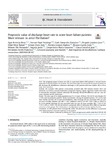Mostrar o rexistro simple do ítem
Prognostic value of discharge heart rate in acute heart failure patients: more relevant in atrial fibrillation?
| dc.contributor.author | Agra Bermejo, Rosa | |
| dc.contributor.author | Pascual Figal, Domingo A. | |
| dc.contributor.author | Gude Sampedro, Francisco | |
| dc.contributor.author | Delgado-Jiménez, Juan F. | |
| dc.contributor.author | Vidal-Pérez, Rafael Carlos | |
| dc.contributor.author | Gómez Otero, Inés | |
| dc.contributor.author | Ferrero-Gregori, Andreu | |
| dc.contributor.author | Álvarez-García, Jesús | |
| dc.contributor.author | Worner Diz, Fernando | |
| dc.contributor.author | Segovia, Jesús | |
| dc.contributor.author | Crespo-Leiro, María Generosa | |
| dc.contributor.author | Cinca Cuscullola, Juan | |
| dc.contributor.author | Fernández-Avilés, Francisco | |
| dc.contributor.author | González-Juanatey, J.R. | |
| dc.date.accessioned | 2020-04-01T12:50:15Z | |
| dc.date.available | 2020-04-01T12:50:15Z | |
| dc.date.issued | 2020-02 | |
| dc.identifier.citation | Agra Bermejo R, Pascual-Figal D, Gude Sampedro F, et al. Prognostic value of discharge heart rate in acute heart failure patients: more relevant in atrial fibrillation? Int J Cardiol Heart Vasc. 2020; 26 | es_ES |
| dc.identifier.issn | 2352-9067 | |
| dc.identifier.uri | http://hdl.handle.net/2183/25286 | |
| dc.description.abstract | [Abstract] Aims. The prognostic impact of heart rate (HR) in acute heart failure (AHF) patients is not well known especially in atrial fibrillation (AF) patients. The aim of the study was to evaluate the impact of admission HR, discharge HR, HR difference (admission-discharge) in AHF patients with sinus rhythm (SR) or AF on long- term outcomes. Methods. We included 1398 patients consecutively admitted with AHF between October 2013 and December 2014 from a national multicentre, prospective registry. Logistic regression models were used to estimate the association between admission HR, discharge HR and HR difference and one- year all-cause mortality and HF readmission. Results. The mean age of the study population was 72 ± 12 years. Of these, 594 (42.4%) were female, 655 (77.8%) were hypertensive and 655 (46.8%) had diabetes. Among all included patients, 745 (53.2%) had sinus rhythm and 653 (46.7%) had atrial fibrillation. Only discharge HR was associated with one year all-cause mortality (Relative risk (RR) = 1.182, confidence interval (CI) 95% 1.024–1.366, p = 0.022) in SR. In AF patients discharge HR was associated with one year all cause mortality (RR = 1.276, CI 95% 1.115–1.459, p ≤ 0.001). We did not observe a prognostic effect of admission HR or HRD on long-term outcomes in both groups. This relationship is not dependent on left ventricular ejection fraction. Conclusions. In AHF patients lower discharge HR, neither the admission nor the difference, is associated with better long-term outcomes especially in AF patients. | es_ES |
| dc.language.iso | eng | es_ES |
| dc.publisher | Elsevier | es_ES |
| dc.relation.uri | https://doi.org/10.1016/j.ijcha.2019.100444 | es_ES |
| dc.rights | Atribución-NoComercial-SinDerivadas 3.0 España | es_ES |
| dc.rights.uri | http://creativecommons.org/licenses/by-nc-nd/3.0/es/ | * |
| dc.subject | Heart rate | es_ES |
| dc.subject | Acute heart failure | es_ES |
| dc.subject | Sinus rhythm | es_ES |
| dc.subject | Atrial fibrillation | es_ES |
| dc.subject | Mortality | es_ES |
| dc.title | Prognostic value of discharge heart rate in acute heart failure patients: more relevant in atrial fibrillation? | es_ES |
| dc.type | info:eu-repo/semantics/article | es_ES |
| dc.rights.access | info:eu-repo/semantics/openAccess | es_ES |
| UDC.journalTitle | IJC Heart & Vasculature | es_ES |
| UDC.volume | 26 | es_ES |
| UDC.startPage | 100444 | es_ES |
Ficheiros no ítem
Este ítem aparece na(s) seguinte(s) colección(s)
-
INIBIC-ICATC - Artigos [177]
-
GI- GRINCAR - Artigos [226]








